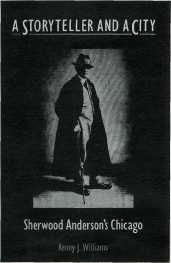 |
Home | Search | Browse | About IPO | Staff | Links |
 |
Home | Search | Browse | About IPO | Staff | Links |
|
Illinois Issues Summer Book Section Chicago's storyteller: Anderson's urban cycle By FREDERICK C. STERN Kenny Williams. A Storyteller and a City: Sherwood Anderson's Chicago.  Sherwood Anderson is best known for his Winesburg, Ohio, a book about a small town and about why George Willard — its young journalist —eventually leaves it. Kenny Williams, professor of English at Duke, pays scant attention to Winesburg, however. She focuses on those novels where Anderson uses Chicago as a crucial locale, and on others, written later, which she argues use a generic city as setting. She devotes chapters to Windy McPherson's Son (1916) and Marching Men (1917), and also examines the novels Poor White (1920), Many Marriages (1923) and Dark Laughter (1925) as well as Anderson's two collections of poems. In these works, she maintains, "Chicago, as a representation of the disorder of American civilization, continued to plague him. Essentially, his fiction provided a forum for thinking through various situations as he attempted to grapple with the role of the individual in a world that generally had distorted the meaning of self-reliance by equating it with extreme selfishness or perverted notions of strength. Moreover, the formlessness and chaos of urban life provided no viable options." As I understand a major aspect of Williams' multi-faceted argument, she views Anderson as a writer who, though sharply conscious of the difficulties of living in newly urban centers of the nation like Chicago, continued to believe that "despair was not the only solution" and that "... the individual — in spite of overwhelming odds, whether personal, environmental, social or economic — could achieve moments of self-reliance." She bases her position on close reading of the works already mentioned, on letters and on other biographical data — agreeing with the commonly held notion that much of Anderson's fiction can be traced to autobiography. She also reveals an exhaustive knowledge of Chicago history. This produces an interesting and worthwhile book, informative about
I confess to some ambivalence, however, about the book's argument — an ambivalence partly engendered by Williams' own commentary. Too often she almost apologizes for dealing with these lesser known works of Anderson's. She admits the clumsiness of his many authorial intrusions; she comments about the contrivance of the "frame" device he favored — which is one of the finest things about Winesburg, but not so fine in several of his other works; she acknowledges the severe limitations of his poetry. Williams seems to be saying that these are not really books in the same class as Winesburg, but that they ought to be considered anyhow because Anderson was doing something interesting here. I certainly agree that the total body of Sherwood Anderson's work is worth considering. I have long thought Windy McPherson's Son a better novel than its detractors grant. I find Poor White interesting (though also somewhat more seriously racist than Williams seems to think). But even as the current reshaping of the American literary canon proceeds, even as we rethink our notions of some pure and abstract literary "good," I find that nothing else in Anderson's large output approaches the grace, the interest, the sheer power, the — for its time — technical innovativeness of Winesburg. I don't doubt Williams' thesis. I agree that what she calls in the title of her last chapter "Sherwood Anderson's Urban Cycle" does essentially what she says it does, but I am not so sure about its importance. Though her study properly focuses on an important aspect of Anderson's role in our literature, it does not, finally, convince me that anything except Winesburg and some of his short stories are major achievements. Williams contrasts Anderson's "urban" novels with those of other figures of the Chicago Renaissance, and — if not directly, then by implication — to the detriment of the latter. When she writes that ". . .his observations ultimately must be evaluated in terms of their narrative frames," I think she is quite right. She does not convince me, however, that his "frames" are nearly as good as those developed by others — Theodore Dreiser, most of all, but also later writers such as Richard Wright, Nelson Algren or Willard Motley (who is not mentioned by Williams at all). By raising important and interesting questions, nonetheless, this volume makes a significant, useful addition to the already large library of Sherwood Anderson criticism. The "Bibliographic Essay" at the end of the volume is, in itself, worth reading and demonstrates Williams' erudition about her subject matter.□ Frederick C. Stern is associate professor of English at the University of Illinois at Chicago. He is the author of F.O. Matthiessen: Christian Socialist as Critic (1981) and the editor of The Revolutionary Poet in the United States: The Poetry of Thomas McGrath (1988). July 1989 | Illinois Issues | 30
|